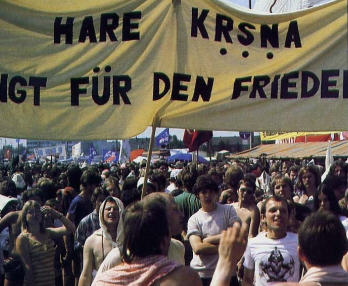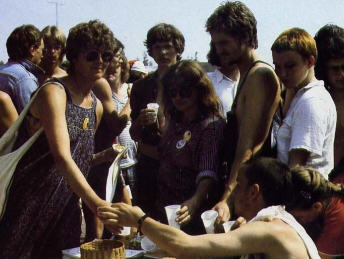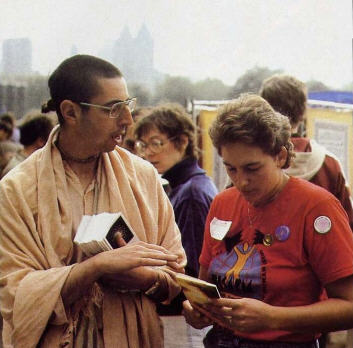Report from New York
Some were there to drink or get high, find a girl or bring their own, and have a good time. Others had some political or social view to push the Socialist Labor Party or what have you. And still others, the majority I suppose, came to express well, in a word, fear. Fear that thermonuclear weapons might blow the world, or a big part of it or at least their part of it to pieces. Hot pieces.
As one sign had it, a sign a child was holding in her hand, "I don't want to be melted." These people know what a nuclear bomb can do. And if you're not up on the gruesome details, Physicians for Social Responsibility, Ground Zero, and other groups are working to make sure you get the picture: The blast. The heat. The winds. The shock waves. The fallout. Your neighbors sick, bloody, and dead all around you. Your family
And finally you yourself, annihilated. Or worse than annihilated. (Under what specific circumstances at what threshold of pain and torture would you prefer to be put out of your misery?)
So people are concerned scared about what might happen. And they want to do something about it.

Hare Krsna Kirtan in New York City's Central Park
And the idea of a cause we all can agree on a whole park full of us, not only Joan Baez or Dr. Spock but even Mayor Koch, even the 4,000 cops keeping order, even The New York Times and CBS well, it's heartening.
A mellow afternoon of human beings coming together in the park to call for restraint, for sanity, for human brotherhood, for peace. As you see all those people out there with you, as you listen to the songs and speeches, as that lump comes to your throat and that feeling of hope floods your heart, you know, you just know, things can change. Or can they?
We sat a little apart from the demonstration, outside the main center of action. On a lawn by a park drive, near the obelisk behind the Metropolitan Museum of Art, our group sat in the sun, on a bright blue cloth, chanting Hare Krsna, Hare Krsna, Krsna Krsna, Hare Hare/ Hare Rama, Hare Rama, Rama Rama, Hare Hare.
That Hare Krsna vibration, we knew, was eternal. And for that matter, what was happening at the peace march was also eternal. People would always come together to search for peace, to cry out against war and destruction, to stand up and be counted for the sacredness of human life. And their efforts would always fail. The arrows would always be released, the muskets shot, the missiles launched, the bombs exploded.
The way we saw it, neither the war-makers nor the peacemakers had the answer.
The warmakers: security through strength. You know just what that means bigger, faster, more horrible weapons. And no way are we going to make them and not use them. They have a life of their own. You can't build those missiles and just keep them in their silos, any more than you can own a dog and keep it from voiding its bladder.
And the peacemakers: Their hearts are in the right place. But the Russians are poised for war, folks. Whatever the rhetoric, whatever the gestures, the nuclear Ivan the Terrible would like nothing better than to blow Manhattan Island to smithereens Central Park and all.
The trouble is: The Russians have all sorts of people sweet and nasty, peaceloving and warloving, sensitive and brutish and so do we. The Russians are tightly bound by their karma, and so are we. The Russians don't know who they are, and neither do we. The Russians have forgotten Krsna, and so have we.
We're not Russians or Americans. We're eternal spiritual beings, all of us. And none of us have any business staying in this material world. This material world is designed by nature to be a miserable place, a place of fear, suffering, and death. Do you really think that marching on the UN or Central Park will change that?
Whether you're obliterated by nuclear weapons, by conventional weapons, or by the weapons in nature's own arsenal, every man, woman, and child on earth is going to die, no matter what we do. The only question is whether we're going to die like human beings or die like dogs.

Krsna Kirtan Youth
All right, we're all going to die like dogs death is death. But at least we shouldn't live like dogs. Dogs live without self-realization. They just eat, sleep, have sex, and fight over which dog gets which bone, which territory, which bitch. And the nuclear arms race is just another sign that men, those most noble of all creatures, are busy barking and clawing to be top dogs, scrambling for their own comfort, their own pleasure, their own human counterparts of bones and bitches. Dogs want peace too. They want to chew their bones and raise their puppies in peace.
But by chanting Hare Krsna, we were moving toward a peace beyond all this, an eternal, unconditional, unassailable peace. And we were giving those who heard us a way to move toward that peace too. It was the peace that comes when we free ourselves from thinking that we are whatever our minds and bodies make us, that whatever we can grab and hold on to is ours, and that the hands that must balance the fate of the earth are ultimately our own.
It was the peace that comes when we look inside ourselves inside our bodies, inside our minds and find a still higher self, a self that can't be melted, burned, gassed, bayonetted, or blasted apart, a self that lives forever, come what may.
It was the peace that comes when we see that the stuff we call our own our homes, our nations, our families, our skins all arrive on loan from time's prop department and get sent back Federal Express after each scene is over.
It was the peace that comes when we see that the fate of the earth is resting in the transcendental hands of Krsna. The Krsna conscious person sees Krsna's hands everywhere, and holds on to those hands in love. Those who ignore Krsna take their fate into their own hands and come out empty-handed.
Sometime early in the afternoon, our group had gone chanting into the center of the crowds. While we were there, a press photographer in blue jeans clicked off a shot of us chanting behind a little girl who held a hand-lettered cardboard sign: SURVIVE.
I'm not sure what irony the photographer saw in this, but we saw a meaning of our own. In one sense, no one in the park would survive. Sooner or later, war or no war, nuclear-bombed or not, every one of us would die. And in another sense spiritually all of us would survive forever. But those who thought of life a the life of the body who wanted to live on in this material world, grab what they could, hold on to what they had, and enjoy it would survive only in a perpetual cycle of birth and death.
And those who lived to love Krsna would survive in freedom.
Jayadvaita Swami.
Report from Bonn
On a warm, clear day last June; Ronald Reagan came to Bonn. So did at least 300,000 peace demonstrators. And so did twenty-five members of the Hare Krsna movement. Each Reagan, the peace marchers, and the devotees of Krsna presented a program for demilitarization and for reducing world tensions.

President Reagan told the German federal parliament that his program for a massive buildup of U.S. military strength was a sure sign of American determination to live up to its commitment of protecting its allies. "You are not alone," he reassured the German people. Then, after brandishing the big stick, the President spoke softly, repeating his proposals for eliminating intermediate-range nuclear weapons in Europe and reducing strategic nuclear arms.
Reagan also introduced a new peace plan by suggesting that NATO and the Warsaw Pact nations mutually cut back their conventional forces. Referring to the demonstrators, he said, "To those who march for peace, my heart is with you. I would be at the head of your parade if I believed marching alone could bring about a more secure world. . . . The question is how to proceed." The President's speech was interrupted twenty-one times by applause.
The peace marchers did what peace marchers do everywhere: They paraded with signs and banners, sang songs and chanted slogans, and listened to impassioned speeches by antinuke leaders. Joseph Beuys, Germany's top modern artist and sculptor, entertained the crowd with an ironic song of his own composition: "Sonnenschein Statt Reagan" ("Sunshine Instead of Reagan" a play upon the German word regen, which means "rain").
But there were problems amid all the idealism. The Bonn demonstration was organized by an uneasy alliance of the German Communist Party (DKP) and the Greens, a coalition of young and politically aware environmentalists who define their ideology as an alternative to both capitalism and communism. At one point during the planning stages the Greens pulled out, accusing the DKP of manipulating the event for Moscow's interests. They grudgingly attended the demonstration anyway, but kept a low profile. Peace groups sponsored by the German Lutheran Church stayed home, fearing that the demonstration would appear too anti-American. Peace groups from Holland also stayed away, fearing that the demonstration was too nationalistic. Gerd Bastian, a former general in the West German army who had retired from his post as the commander of a panzer division to stump for peace, was on hand to represent the peace-loving members of the establishment. But radical hecklers interrupted his speech. And another speaker ruefully noted that too many demonstrators, and the devotees of Krsna.
President Reagan's speech, for all its charm and enthusiasm, was contradictory, in keeping with the Alice-in-Wonderland logic of the arms race itself. It called to mind that favorite cliche of the Vietnam War: "To save the village we must destroy it." To preserve the peace we must build more weapons and talk about disarmament. The Russians have already promised the world that if America boosts its military might, they will follow suit, missile for missile, bomb for bomb. And as both sides increase their already astronomical capacity for overkill, they talk about reducing it.
As for the peace demonstrators, they clearly showed the flawed premise underlying their materialistic idealism: "We are our bodies, so let's save them." As soon as we define our existence in physical terms, we become entangled in all sorts of dualities: heat and cold, happiness and distress, love and hate, birth and death. The Bonn peace march was beset with a myriad of dualities: Communists versus environmentalists, liberals versus radicals, Germans versus Dutch, young versus old, the serious versus the whimsical all hoping for peace versus war in an existence of life versus death.

Srila Niranjana Swami
Dualities of pleasure and pain, birth and death, peace and war are insurmountable on the bodily platform. Therefore, if we want real peace we must rise above the bodily platform and understand ourselves to be spiritual beings, unchanging and indestructible.
We are not our bodies; we are eternal spiritual souls living in temporary conglomerations of matter called bodies. This was the message of the Hare Krsna devotees on that fine June day in Bonn. We are seeking peace in this human life only because as spiritual entities we hanker for that half-remembered "peace of God, which passeth all understanding." This is the eternal peace of Lord Krsna's own spiritual kingdom, where everyone centers his love and his energy on God. In God's kingdom there are no dualities, no pain, no death, no war only perfect harmony.
This harmony and perfect peace are available even in this material world, once we reject the petty distinctions between nations, races, and ideologies (all of which stem from our misidentification with the body) and accept our true oneness as spiritual souls, servants of the Supreme Soul, Krsna.
Now we are experiencing the duality of matter and spirit because we are out of harmony with Krsna's desire. We have forgotten Him by misusing our free will.
In this Age of Quarrel, we can reestablish our relationship with Him by the simple, sublime process of chanting Hare Krsna and accepting the Lord's mercy in the form of prasadam, vegetarian food offered to the Lord in love. By centering our lives on Krsna instead of on the struggle to preserve the ever-dying fleshy covering of the soul, we can experience peace by His grace, even in this material world.
Those who argue that Krsna consciousness is too simple and naive to solve the complex problems of the world are themselves too complex they're unwilling to let go of the dualities that bind them. The struggle against the death of the body is hopeless. But hope for peace matures into realization as soon as we take a step in the right direction away from material duality and toward spiritual reality.
The Krsna consciousness movement is itself the testing ground of this principle, and the proof of the principle is available for anyone to experience.
Suhotra dasa
